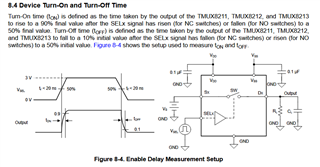Other Parts Discussed in Thread: TMUX8213, TMUX8211
Hello,
I am looking for clarification on the language used in the datasheet for TMUX821x. I am using the TMUX8212 variant, which is the normally open version.
I am trying to understand the time from the "SEL" signal going high, to the switch closing (opposite of the default state). In table 9-2 this is called "Channel ON".
Then in Figure 8-4 we see the following set up, and language that implies that the parameter "t_on" is the time to output change after the FALLING edge of the "SEL" signal, and therefore the time to return to default state.
Here are the timing characteristics from section 7.13:
My final conclusion is that for TMUX8212 Normally Open variant, the timing characteristics as seen in section 7.13 can be described as follows:
- tON (EN) = 4us typ. = the time for the switch to open (return to default state).
- tOFF (EN) = 100ns typ. = the time for the switch to close.
Is my understanding correct?
Thanks for your help!

